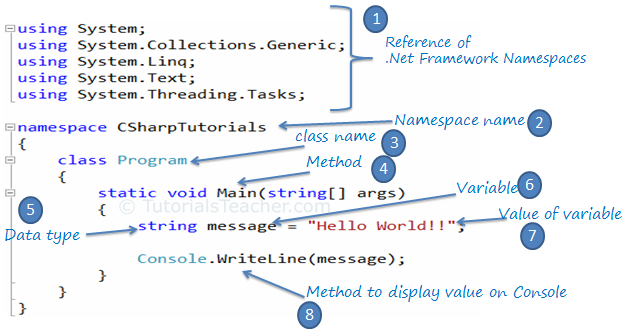First C# Program:
In the previous section, we have created a console project. Now, let's write simple C# code to understand important building blocks.
Every console application starts from the Main() method of Program class. The following example code displays "Hello World!!" on the console.
Example: Simple Console Project with C#
using System;
using System.Collections.Generic;
using System.Linq;
using System.Text;
using System.Threading.Tasks;
namespace CSharpTutorials
{
class Program
{
static void Main(string[] args)
{
string message = "Hello World!!";
Console.WriteLine(message);
}
}
}
The following image illustrates the important parts of the above example.
 C# Program
C# Program
Explaination of above points:
- Every .NET application takes the reference of the necessary .NET framework namespaces that it is planning to use with the "using" keyword e.g.
using System.Text
- Declare the namespace for the current class using the "namespace" keyword e.g.
namespace CSharpTutorials.FirstProgram
- We then declared a class using the "class" keyword:
class Program
- The Main() is a method of Program class which is the entry point of the console application.
- String is a data type.
- 'message' is a variable, that holds a value of a specified data type.
- "Hello World!!" is the value of the message variable.
- Console is a .NET framework class. WriteLine() is a method which you can use to display messages to the console.
Note :
Every line or statement in C# must end with a semicolon (;).
Compile and Run C# Program:
In order to see the output of the above C# program, we have to compile it and run it by pressing Ctrl + F5, or clicking Run button or by clicking the "Debug" menu and clicking "Start Without Debugging". You will see following output in the console:
Hello World!!
So this is the basic code items that you will probably use in every C# code. Let's learn about C# Class in the next section.